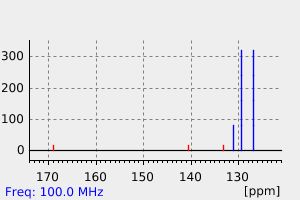4-chloro-5-nitro-2-phenylthiazole
中文名称
——
中文别名
——
英文名称
4-chloro-5-nitro-2-phenylthiazole
英文别名
Thiazole, 4-chloro-5-nitro-2-phenyl-;4-chloro-5-nitro-2-phenyl-1,3-thiazole
CAS
——
化学式
C9H5ClN2O2S
mdl
——
分子量
240.67
InChiKey
UJYOBZOYYFXFLQ-UHFFFAOYSA-N
BEILSTEIN
——
EINECS
——
-
物化性质
-
计算性质
-
ADMET
-
安全信息
-
SDS
-
制备方法与用途
-
上下游信息
-
文献信息
-
表征谱图
-
同类化合物
-
相关功能分类
-
相关结构分类
计算性质
-
辛醇/水分配系数(LogP):3.7
-
重原子数:15
-
可旋转键数:1
-
环数:2.0
-
sp3杂化的碳原子比例:0.0
-
拓扑面积:87
-
氢给体数:0
-
氢受体数:4
反应信息
-
作为反应物:描述:4-chloro-5-nitro-2-phenylthiazole 在 sodium azide 作用下, 以 N,N-二甲基甲酰胺 为溶剂, 反应 0.25h, 以56%的产率得到4-azido-5-nitro-2-phenylthiazole参考文献:名称:Neighbouring group effects on rates of thermolysis of 4-azidothiazoles摘要:Rate measurements for thermolysis of 4-azidothiazoles in p-xylene solution have identified neighbouring group effects from nitro (19-fold rate increase), phenyliminomethyl (16), formyl (4.5) and acetyl (2.2) substituents in the 5-position. These effects are very similar in magnitude to those measured for 3-azidothiophenes, whereas in azidobenzenes the rate increases are much larger, 5-Substituents in 4-azidothiazole which are capable of conjugative donation (phenyl, ethyl propenoate) also increased the reaction rate. The reactions involving neighbouring group participation led to cyclized products from the 4-azidothiazoles though not all of these products were stable under the thermolysis conditions. (C) 1997 Elsevier Science Ltd.DOI:10.1016/s0040-4020(97)00638-8
-
作为产物:描述:参考文献:名称:Neighbouring group effects on rates of thermolysis of 4-azidothiazoles摘要:Rate measurements for thermolysis of 4-azidothiazoles in p-xylene solution have identified neighbouring group effects from nitro (19-fold rate increase), phenyliminomethyl (16), formyl (4.5) and acetyl (2.2) substituents in the 5-position. These effects are very similar in magnitude to those measured for 3-azidothiophenes, whereas in azidobenzenes the rate increases are much larger, 5-Substituents in 4-azidothiazole which are capable of conjugative donation (phenyl, ethyl propenoate) also increased the reaction rate. The reactions involving neighbouring group participation led to cyclized products from the 4-azidothiazoles though not all of these products were stable under the thermolysis conditions. (C) 1997 Elsevier Science Ltd.DOI:10.1016/s0040-4020(97)00638-8
表征谱图
-
氢谱1HNMR
-
质谱MS
-
碳谱13CNMR
-
红外IR
-
拉曼Raman
-
峰位数据
-
峰位匹配
-
表征信息
同类化合物
(SP-4-1)-二氯双(1-苯基-1H-咪唑-κN3)-钯
(5aS,6R,9S,9aR)-5a,6,7,8,9,9a-六氢-6,11,11-三甲基-2-(2,3,4,5,6-五氟苯基)-6,9-甲基-4H-[1,2,4]三唑[3,4-c][1,4]苯并恶嗪四氟硼酸酯
(5-氨基-1,3,4-噻二唑-2-基)甲醇
齐墩果-2,12-二烯[2,3-d]异恶唑-28-酸
黄曲霉毒素H1
高效液相卡套柱
非昔硝唑
非布索坦杂质Z19
非布索坦杂质T
非布索坦杂质K
非布索坦杂质E
非布索坦杂质D
非布索坦杂质67
非布索坦杂质65
非布索坦杂质64
非布索坦杂质61
非布索坦代谢物67M-4
非布索坦代谢物67M-2
非布索坦代谢物 67M-1
非布索坦-D9
非布索坦
非唑拉明
雷非那酮-d7
雷西那德杂质2
雷西纳德杂质L
雷西纳德杂质H
雷西纳德杂质B
雷西纳德
雷西奈德杂质
阿西司特
阿莫奈韦
阿考替胺杂质9
阿米苯唑
阿米特罗13C2,15N2
阿瑞匹坦杂质
阿格列扎
阿扎司特
阿尔吡登
阿塔鲁伦中间体
阿培利司N-1
阿哌沙班杂质26
阿哌沙班杂质15
阿可替尼
阿作莫兰
阿佐塞米
镁(2+)(Z)-4'-羟基-3'-甲氧基肉桂酸酯
锌1,2-二甲基咪唑二氯化物
锌(II)(苯甲醇)(四苯基卟啉)
锌(II)(正丁醇)(四苯基卟啉)
锌(II)(异丁醇)(四苯基卟啉)







